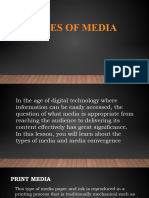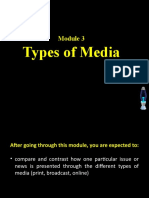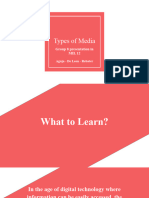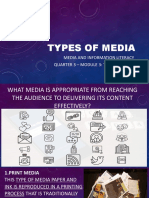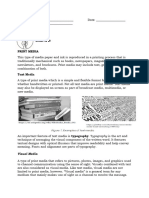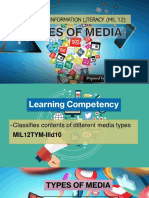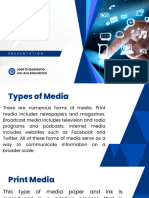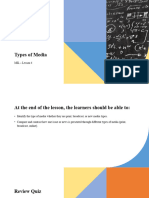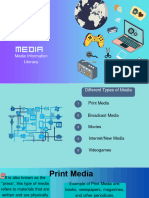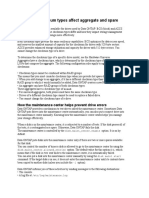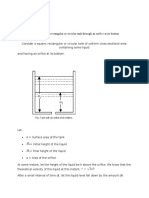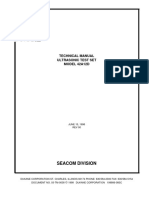Media and Information Literacy
Module 3: Types of Media
PRINT MEDIA
This type of media paper and ink is reproduced in a printing process that is traditionally mechanical such as books,
newspapers, magazines, journals, newsletters, and brochures. Print media may include text, graphics, or a combination of both.
▪ Text Media
A type of print media which is a simple and flexible format for conveying ideas, whether handwritten or printed.
Not all text media are print media. Text media may also be displayed on-screen as part of broadcast media, multimedia,
or new media.
An important feature of text media is typography. Typography is the art and technique of arranging the visual
component of the written word. It features textual designs with optical illusions that improve readability and help
convey meaning. Fonts and alignment are parts of typography.
▪ Visual Media
A type of print media that refers to pictures, photos, images, and graphics used to channel communication
using the sense of sight. Visuals combined with text are also considered as visual media. Like text media, visual media
are not limited to print media, however. “Visual media” is a general term for any medium that mainly makes use of sight
as a channel to receive the message.
An important feature of visual media, in print or elsewhere, is graphic design. It is the process of visual
communication that organizes and presents information developed through a creative process for a particular purpose.
Graphic design is part of your daily life. From things like candy wrappers to huge things like billboards to the T-shirt you
are wearing, graphic designs inform, persuades, organizes, stimulates, locates, identifies, attracts attention, and
provides pleasure.
Examples of Visual Media
1. Informational Graphics (Infographic) – is a visual representation of information to understand the high-volume and
complex data easily, e.g., graphs, charts.
2. Cartoons – a sketch or drawing intended as satire, caricature, or humor, e.g., comic strip, editorial cartoons in
newspapers and magazines.
3. Photography – A photograph is an image created by light captured on a light-sensitive surface, which is usually
photographic film. Nowadays, few people use photographic film. The advent of digital photography via digital cameras
and cellular phones has made taking photographs easier and less expensive.
BROADCAST MEDIA
A type of media that reaches target audiences using airwaves as the transmission medium. Examples of broadcast media
are radio and television.
▪ Audio Media
A type of broadcast media that uses audio or voice recording as a medium in the delivery of information. These
are devices that appeal to the auditory sense.
▪ Multimedia
A type of broadcast media concerned with the computer-controlled integration of text, graphics, drawings, still
and moving images (video), animation, audio, and any other media where every type of information can be stored,
communicated, and handled digitally. Multimedia can be recorded and played, displayed, interacted with or accessed
by information-processing devices, such as high-tech and automated devices, but can also be part of a live presentation.
Multimedia devices are electronic media equipment used to store and play or display multimedia content. In the early
years of multimedia, "rich media", a term with a similar concept was used in advertising. “Hypermedia” is an extension
of multimedia, where photos or graphics are linked to other sources of information.
▪ New Media
A term used to integrate the different technologies emerging on one digital platform to organize and distribute
content. Some examples are podcasts, augmented reality, video games, blogs, and wikis. There are two common
characteristics of new media: disseminating the information to several receivers which is theoretically infinite, in
customized ways, depending on the specification for endorsed categories.
�MEDIA CONVERGENCE
Media convergence refers to the merging of different equipment and tools for producing and distributing news through
digitization and computer networking. It allows media texts to be produced and distributed on multiple media devices. This is
also known as technological convergence. Media convergence is the synergy of communication, computing, and content in the
digital world. A smartphone that has a camera, radio, web browser, video, etc. is an example of converged media.
Activity: Create My Own Media.
Directions: You are tasked to construct a specific sample of print media that delivers your message creatively and deliberately.
Supply the needed information below and make an illustration in the box provided. Your produced output will be rated based on
the rubric below.
Type of media: ________________________________________________________
My media message: ____________________________________________________
My audience: _________________________________________________________
My slogan/title: _______________________________________________________
Example: Disaster Preparedness Campaign (Broadcast Media)
Type of media: TV Public Service Announcement
My media message: Teaching students and families how to prepare for natural disasters.
My audience: Students and community members.
My slogan/title: "Be Ready, Stay Safe!"

